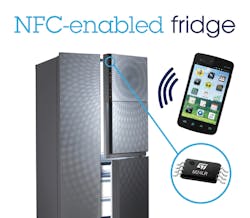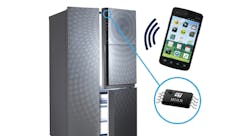Process Technology To Cut Mobile Device Front-End Size
Consumers’ vociferous appetites for faster broadband connections mean that circuitry in mobile devices, like tablets and smartphones, is becoming increasingly complex. In wireless communication devices, the RF front-end circuitry usually incorporates many amplifiers, switches, and tuners. But because today’s high-speed standards, such as IEEE 802.11ac, require multiple frequency bands to increase data throughput, the latest communication equipment requires additional front-end circuitry. Current third-generation (3G) phones use as many as five frequency bands, with 3GPP standards for fourth-generation (4G) Long-Term Evolution (LTE) supporting as many as 40 bands. Consequently, conventional separate components will dramatically increase overall size.
Semiconductor manufacturer STMicroelectronics says it has addressed consumer broadband demands by developing an advanced component process technology that is designed to increase performance and reduce the size of the RF front-end of mobile devices. The new manufacturing process, H9SOI_FEM, allows production of complete integrated front-end module; it is an evolution of the H9SOI Silicon-on-Insulator (SOI) process introduced by ST in 2008, and subsequently used by customers to produce more than 400 million RF switches. ST believes H9SOI_FEM offers the industry’s best figure of merit for antenna switch and antenna tuning devices with Ron x Coff at 207fs2.
From a commercial perspective, smartphones featuring high-speed, multi-band wireless technology are driving demand for RF front-end components, particularly as integrated modules. The number of RF devices in a smartphone is approximately three times as many as those in an entry-level second-generation (2G)/3G phone. This is significant because smartphone sales currently exceed one billion units annually and are growing at around 30% per year, according to analysis by Prismark. Additionally, OEMs want suppliers to provide smaller, thinner components with higher power efficiency. ST sees opportunities for discrete components, as well as integrated power-amplifier/switch and power-amplifier/switch/tuner modules based on its H9SOI_FEM process:
- H9SOI_FEM is a 0.13-μm technology with dual-gate 1.2-V and 2.5-V MOSFETs. Unlike conventional SOI processes—such as those used for discrete devices like RF switches—H9SOI_FEM supports multiple technologies like GO1 MOS, GO2 MOS, and optimized NLDMOS devices. This allows H9SOI_FEM to support full monolithic integration of all key functions of an RF front end. This comprises RF switches, low-noise amplifiers (LNAs), multi-mode multi-band cellular power amplifiers (PAs), diplexers, RF coupling, antenna tuning, and RF energy-management functions.
- GO1 MOS is preferred for very-high-performance LNAs, capable of sustaining very low noise figure with 1.4 dB at 5 GHz, as well as providing threshold frequency (Ft) of 60 GHz. This permits 5-GHz designs with a safety margin. The performance of integrated passive components has also been optimized by depositing as much as three or four aluminum layers and also thick copper when needed.
- H9SOI_FEM is suitable both for devices targeting the low end of the market, where low cost and extensive integration are crucial, as well as the high-end smartphone segment. High-end products typically require a combination of many frequency bands to support 2G, 3G, and 4G standards and other wireless connectivity standards. The latter includes Bluetooth, Wi-Fi, GPS, and near-field communication (NFC) for contactless payments.
Smart Refrigerator
In another area of consumer-related technology, ST has announced that its NFC/RFID-enabled memory device has been integrated in Classe Cube, the latest refrigerator from Dongbu Daewoo Electronics. Classe Cube can communicate with NFC-enabled smartphones. This is made possible by ST’s M24LR dynamic NFC/RFID tag, which stores sensor data from the refrigerator and provides the information to a smartphone (see figure).
ST’s M24LR dynamic NFC/RFID tag designed into this refrigerator means it can communicate with its owners and their smartphones via NFC.
Users can access all the information through the Classe Smart application on their mobile device, enabling more efficient use of the refrigerator based on users’ living habits and plans. The refrigerator can alert users to its door being left open, reports on the temperature in different sections of the refrigerator, and provides a new level of maintenance service. This includes the direct submission of after-sales service requests and remote diagnostics.
About the Author
Paul Whytock
Editor-in-Chief
Paul Whytock is European Editor for Microwaves & RF and European Editor-in-Chief for Electronic Design. He reports on the latest news and technology developments in Europe for his US readers while providing his European engineering audience with global news coverage from the electronics sector. Trained originally as a design engineer with Ford Motor Co., Whytock holds an HNC in mechanical, electrical, and production engineering.

